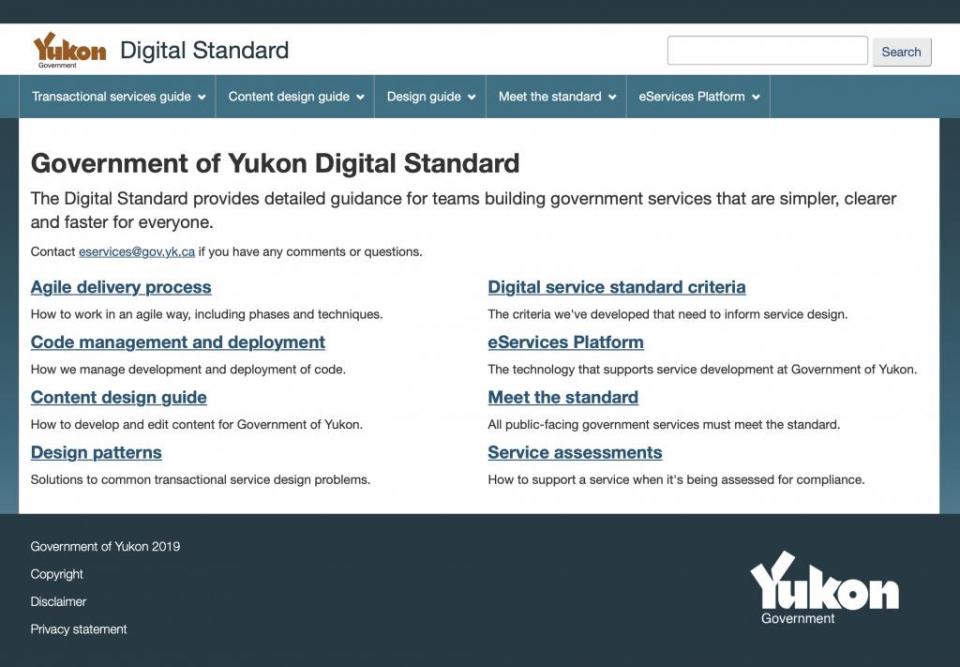
Last month we published a new Digital Service Delivery Guide to replace our Digital Standard. The guide is a collection of best-practice guidance and processes for designing and delivering digital government services that are simple, fast and strive to improve the user experience.
Getting the word out to staff about the website and service guidance
Originally, we used monthly meetings and presentations to communicate the government’s website standards to government staff. Around 8 years ago, we began communicating corporate guidance for the government’s websites on an internal SharePoint site. This site could be viewed by all staff but was focused on the government’s Website Advisory Committee. This group primarily consists of communications professionals who specialize in digital communications.
In 2015, the government formed its eServices for Citizens Branch and we began communicating guidance for building digital services using SharePoint. We also gave presentations and met with departments to go over our processes.
These approaches were effective ways to share information with staff. But we also work with vendors who build digital services and needed a way to ensure they could access these standards. It’s important we’re all on the same page to deliver consistent digital services.
Making the government’s digital standards public
In 2017, leading up to the Yukon.ca content migration project, we started compiling guidance into a beta site we named the “Digital Standard.” This website housed the government’s content design guidance, style guide, the digital service standards and information about transactional services.
While we were proud to have public-facing advice to share with staff and vendors alike, we found the site did have some limitations. And that was the purpose of the beta. It gave us a chance to test out the platform and learn how people used the site.
We’d been adding content to the site as we encountered new situations that required guidance. During this time we were migrating the entire government website to Yukon.ca. As we worked through this process, we had to develop and share new processes and guidance quickly. As a result, we inadvertently added and organized content based on which department owned it.
Over time, as the site grew, it became challenging for users to access the content they needed, when they needed it. It was time to get back to the drawing board and start planning a new site.
Planning for a new digital standard
The 1st thing we did was reach out to our 2 main audiences. These are Government of Yukon staff and vendors we partner with to build digital services. We conducted a survey so we could better understand their experiences using the existing site.
These were the main pain points users described:
- Duplicate content made it hard to tell which page was correct.
- They could not find what they were looking for by search or navigation
- When they did find the page they were looking for, they were not confident the information was up to date.
- The content they were looking for did not exist.
After our vendor determined the new site structure, we tested it using a tree test so we had confidence it would work for our audiences.
We conducted user testing and made adjustments to content before we made the site public. We also renamed it. In addition to digital service standards, the content provides guidance on digital service delivery. So we called it the Digital Service Delivery Guide.
Launching the Digital Service Delivery Guide
We launched the new Digital Service Delivery Guide in November 2020. In addition to rewriting every page, we made the following improvements.
- We made it easier for users to find what they’re looking for by:
- restructuring the site and organizing content by task and theme rather than by government department or content owner;
- removing duplicate content and rewriting the remaining pages;
- including a site search; and
- using tags so users can find related information.
- We identified gaps in content and addressed these by writing new pages. For example, we added:
- the government’s brand standard;
- more guidance on forms;
- information about procurement;
- more online design patterns; and
- a new section with guidance for vendors.
- We made it clear this is the place to look for the government’s official guidance for designing and delivering digital services. To accomplish this we:
- used the government’s branding;
- made all of the page bilingual; and
- featured the date the guidance was added and the date it was last updated so users know it’s current and relevant.
- We made it easy for users to submit feedback and make suggestions for content by adding feedback forms on every page.
The Digital Service Delivery Guide is live. So now what?
The guide is live but we have more work to do. We’re:
- publishing the remaining French pages;
- refining the new content;
- adding more new content to meet user needs; and
- continuously improving the site based on user feedback.
Let us know what you think
After we launch services, we monitor feedback so we can improve the user experience.
If you’d like to share your thoughts, use the feedback form at the bottom of any page of the guide or email eservices@yukon.ca.
